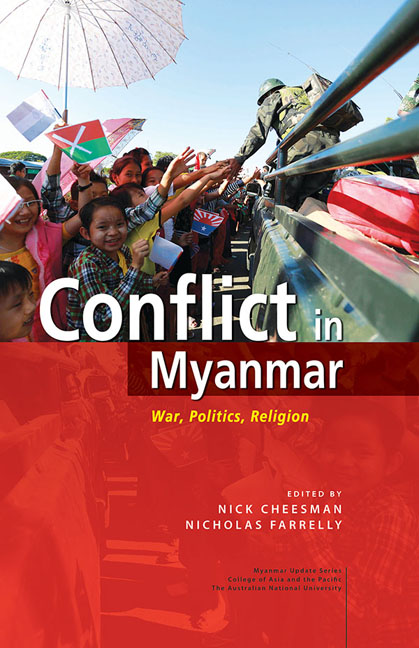Book contents
- Frontmatter
- Contents
- List of Maps
- List of Tables
- List of Figures
- Acknowledgements
- Contributors and Editors
- Part I Introduction
- Part II War and Order
- 2 The politics of policymaking in transitional government: A case study of the ethnic peace process in Myanmar
- 3 Reexamining the centrality of ethnic identity to the Kachin conflict
- 4 A feminist political economy analysis of insecurity and violence in Kachin State
- 5 Pacifying the margins: The Pa-O Self-Administered Zone and the political order in southern Shan State
- 6 Landmines as a form of community protection in eastern Myanmar
- Part III Elections and After
- Part IV Us and Them
- Part V Conclusion
- Abbreviations and Key Terms
- Index
6 - Landmines as a form of community protection in eastern Myanmar
from Part II - War and Order
Published online by Cambridge University Press: 22 July 2017
- Frontmatter
- Contents
- List of Maps
- List of Tables
- List of Figures
- Acknowledgements
- Contributors and Editors
- Part I Introduction
- Part II War and Order
- 2 The politics of policymaking in transitional government: A case study of the ethnic peace process in Myanmar
- 3 Reexamining the centrality of ethnic identity to the Kachin conflict
- 4 A feminist political economy analysis of insecurity and violence in Kachin State
- 5 Pacifying the margins: The Pa-O Self-Administered Zone and the political order in southern Shan State
- 6 Landmines as a form of community protection in eastern Myanmar
- Part III Elections and After
- Part IV Us and Them
- Part V Conclusion
- Abbreviations and Key Terms
- Index
Summary
“Some people want to remove landmines. Some want to keep [them] for security and protection.” — Church leader, Tanintharyi
Myanmar currently ranks third internationally in the number of accidents and deaths from landmines, after Afghanistan and Columbia. While the use of landmines in Myanmar's myriad conflicts has been documented (Geneva Call 2011; Moser-Puangsuwan 2000a; Selth 2000a), the factors determining their inclusion as a form of community protection have been less researched (South 2012).
To better understand the role of landmine use in Myanmar, this chapter uses civilian self-protection frameworks put forward by South, Perhult, and Carstensen (2010) and Jose and Medie (2015) to outline how several historical and cultural factors, including a culture of militarization and the arbitrary role of patron-client relations, have together with the “four-cuts” counterinsurgent strategy created an environment of “chronic emergency” (Duffield 2008, pp. 8–10) for populations living in conflict-affected areas. Concomitantly, it points to a shift of landmine use away from primary military objectives to the targeting and protection of infrastructure, private assets, and community spaces.
This chapter argues that communities have adopted the military use of landmines to establish an element of control within an “emerging political complex” (Duffield 2014, p. 231), posing an immutable choice between the protection of their community and possible causation of physical and psychological trauma of the same local population.
In some circumstances, landmine use can be a form of community agency, not only to deal with insecurity but also to assess risks on the community's own terms (Bottomley 2001; KHRG 2008). Often communities are left with an immutable decision between the dangers of landmine use or exposure to other threats. They undertake risk assessments that weigh the risk of landmine use against other threats.
These findings are derived from research gathered as part of two Knowledge, Attitude, and Practices (KAP) surveys, the first representative of a population of 110,000 people across east Bago and Tanintharyi Regions, and Mon, Kayin, and Kayah States who have been directly impacted by landmine accidents. The second was on a population of 100,000 internally displaced persons residing in various locations across northern Shan and Kachin States. The surveys included a series of extensive coordination meetings and interviews with stakeholders, from senior and junior officials in government, ethnic armed groups (EAGs), and CSOs, as well as participant observation of interactions among these groups.
- Type
- Chapter
- Information
- Conflict in MyanmarWar, Politics, Religion, pp. 121 - 136Publisher: ISEAS–Yusof Ishak InstitutePrint publication year: 2016



